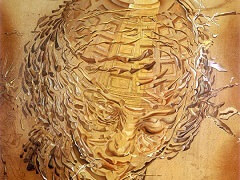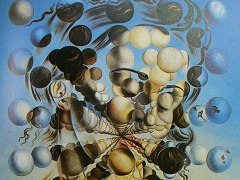Ballerina in a Death's Head, 1939 by Salvador Dali

Ballerina in a Death's Head falls under the category of the paranoiac-critical method, which is Dali's biggest contribution to the art world. His paintings feature a sort of ambiguity, dual concepts that have no link whatsoever. Optical illusions involve faces created by silhouettes of people or structures of buildings, tables, glasses, fruits and so on. Dali developed the paranoiac-critical method in the early 1930s, with an intention to impress his hero, Sigmund Freud.
The aspect of paranoia that Dali was interested in was the ability of the brain to perceive links between things that rationally are not linked. Dali described the paranoiac-critical method as a "spontaneous method of irrational knowledge based on the critical and systematic objectivity of the associations and interpretations of delirious phenomena." Employing the method when creating a work of art uses an active process of the mind to visualize images in the work and incorporate these into the final product. An example of the resulting work is a double image or multiple images in which an ambiguous image can be interpreted in different ways.























